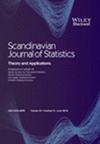Selection of linear mixed‐effects models for clustered data
IF 1
4区 数学
Q3 STATISTICS & PROBABILITY
引用次数: 0
Abstract
We consider model selection for linear mixed‐effects models with clustered structure, where conditional Kullback–Leibler (CKL) loss is applied to measure the efficiency of the selection. We estimate the CKL loss by substituting the empirical best linear unbiased predictors (EBLUPs) into random effects with model parameters estimated by maximum likelihood. Although the BLUP approach is commonly used in predicting random effects and future observations, selecting random effects to achieve asymptotic loss efficiency concerning CKL loss is challenging and has not been well studied. In this paper, we propose addressing this difficulty using a conditional generalized information criterion (CGIC) with two tuning parameters. We further consider a challenging but practically relevant situation where the number, m$$ m $$ , of clusters does not go to infinity with the sample size. Hence the random‐effects variances are not consistently estimable. We show that via a novel decomposition of the CKL risk, the CGIC achieves consistency and asymptotic loss efficiency, whether m$$ m $$ is fixed or increases to infinity with the sample size. We also conduct numerical experiments to illustrate the theoretical findings.聚类数据线性混合效应模型的选择
我们考虑具有聚类结构的线性混合效应模型的模型选择,其中使用条件Kullback-Leibler (CKL)损失来衡量选择的效率。我们通过将经验最佳线性无偏预测因子(eblps)替换为随机效应,并使用最大似然估计的模型参数来估计CKL损失。虽然BLUP方法通常用于预测随机效应和未来的观测结果,但选择随机效应来实现CKL损失的渐近损失效率是具有挑战性的,并且尚未得到很好的研究。在本文中,我们建议使用具有两个调优参数的条件广义信息准则(CGIC)来解决这一困难。我们进一步考虑一个具有挑战性但实际相关的情况,即集群的数量m $$ m $$不会随着样本量的增加而趋于无穷大。因此,随机效应的方差不是一致可估计的。我们表明,通过一种新的CKL风险分解,CGIC实现了一致性和渐近损失效率,无论m $$ m $$是固定的还是随样本量增加到无穷大。我们还进行了数值实验来说明理论结果。
本文章由计算机程序翻译,如有差异,请以英文原文为准。
求助全文
约1分钟内获得全文
求助全文
来源期刊

Scandinavian Journal of Statistics
数学-统计学与概率论
CiteScore
1.80
自引率
0.00%
发文量
61
审稿时长
6-12 weeks
期刊介绍:
The Scandinavian Journal of Statistics is internationally recognised as one of the leading statistical journals in the world. It was founded in 1974 by four Scandinavian statistical societies. Today more than eighty per cent of the manuscripts are submitted from outside Scandinavia.
It is an international journal devoted to reporting significant and innovative original contributions to statistical methodology, both theory and applications.
The journal specializes in statistical modelling showing particular appreciation of the underlying substantive research problems.
The emergence of specialized methods for analysing longitudinal and spatial data is just one example of an area of important methodological development in which the Scandinavian Journal of Statistics has a particular niche.
 求助内容:
求助内容: 应助结果提醒方式:
应助结果提醒方式:


